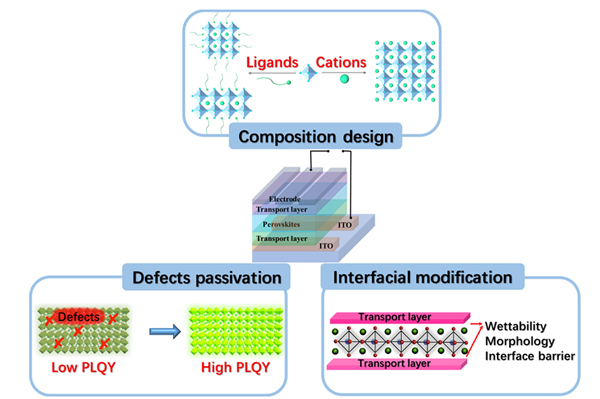摘要/Abstract

有机-无机杂化钙钛矿发光二极管(LED)的性能在短短几年时间内飞速提升, 近红外光器件的效率已达21.6%, 绿光器件效率也达到20.3%, 达到可以和商业化的有机发光二极管媲美的水平; 即使是稍有逊色的稳定性方面也有很大进展, 报道的最长器件半衰期已达到250 h. 器件性能的飞速提升得益于钙钛矿本身优异的光电性质, 而且通过丰富的化学手段可进一步对钙钛矿材料的组分和结构进行调控, 从而优化器件性能. 本综述从组分设计、缺陷钝化和界面修饰的角度出发, 重点分析了组分和结构设计对钙钛矿LED器件效率和稳定性的影响, 最后对钙钛矿发光二极管的未来发展进行展望.
关键词: 钙钛矿, 发光二极管, 组分设计, 缺陷钝化, 界面修饰
Over the past few years, the external quantum efficiency (EQE) of organic-inorganic hybrid perovskite light-emitting diodes (LEDs) has experienced a tremendous progress. The reported highest EQE of infrared and green perovskite LEDs has reached 21.6% and 20.3%, respectively, which is comparable to commercial organic light-emitting diodes. Even the slightly inferior blue perovskite LEDs have a recorded EQE of 12.3%. However, poor device stability is the biggest problem hindering the commercial application of perovskite optoelectronic devices, which is a severer problem in LEDs because the higher operating voltage will trigger acute ion migration. Encouragingly, however, the lifetime of perovskite LEDs has increased from the initial several seconds to over 200 hours, presenting a dramatic progress. The outstanding performance of perovskite LEDs is closely related with the excellent material properties, including tunable bandgaps, narrow full width at half maximum (FWHM), high defect tolerance, high electron/hole mobility and solution processibility. Moreover, the diversity of components and structure of perovskite makes the addition of various additives effective, enabling optimizing device performance through kinds of chemical methods. In this review, we analyzed the impacts of component and structure designing on the efficiency and stability of perovskite LEDs from the perspective of compositional designing, defect passivation and interfacial modification. We analyzed how compositional designing affects the optoelectronic properties through altering the ratio between organic and inorganic components or adding other molecules and ions to adjust the dimension of perovskites. As for defect passivation, we discussed various passivating reagents and their working mechanism. In addition, we summarized the significance of interfacial modification between different functional layers, including improving the wetting property of the substrates, achieving higher crystal quality of perovskite films, passivating the defects at the interfaces, blocking leakage current and reducing hole/electron injecting barrier. Finally, we discussed the scientific and technological challenges yet to be resolved before perovskite LEDs can be considered for commercial applications.
Key words: perovskite, light-emitting-diodes, compositional design, defect passivation, interfacial modification
PDF全文下载地址:
点我下载PDF
